This is a guest post by Caleb Cousens from SocialMediaWizard.com
All the cool kids are doing it!
It’s the hottest thing in marketing right now.
It’s creative, informal, and effective and needs to play a role in your online marketing strategy moving forward.
Emoji marketing has arrived.
But why are emoji so effective?
Why are some of the world’s top brands, from GE to 20TH Century Fox to Taco Bell, leading the charge?
And what are some easy ways to use emoji in YOUR marketing?
Science Says Emoji Rock
Marketers and brands have been saying for years how important visual content is to our content mix.
But why?
90% of all information that comes to the brain is visual and it only takes us an average of 0.25 seconds to process it.
The human brain is hardwired to make sense of visual information more efficiently than textual.
Social media wants more visual content
Indeed our brains are built to process images WAY faster than text. 60,000 times faster, in fact.
The way social media is going is showing us as much.
- Facebook is upping the importance of video content on the network.
- Instagram now allows 15-second videos.
- Twitter has Vine, plus expanded native video uploads to 140 seconds.
- Engagement per follower is 58 times higher on Instagram than on Facebook.
So,
- if visual content gets more engagement,
- and our audience can process it quicker,
- giving us marketers more chances to convert them…
…then why would we ever go back to plain text?
Emoji are visual content at our fingertips
Over 63% of social media is now made up of visual content and emoji are visuals at our fingertips.
In fact, they are now a mainstay in the language used online – you can’t escape those little yellow faces anywhere you go!
It’s no wonder – studies have found that emoji can have the same effect on the receiver as looking at a smiling face in real life.
And for those who still think that emoji are unprofessional and not for use in more formal settings, these findings indicate that even when four emojis were used, it had little to no effect on the sender’s credibility.
Brief History of Emoji
Emoji come from the mysterious land of Japan.
The concept was created by a Japanese communication firm in the 1990’s.
‘Emoji’ in Japanese literally means ‘picture word‘.
Their purpose? To represent an idea or emotion in digital communication.

World’s first emoji
(image from Emoji: A Lovely History on Medium)
But how did we get from Japan in the 1990’s to now?
Well, we have Steve Jobs to thank for that one.
Mr. Jobs was on a trip to Japan to promote his first iPhone. He hit a snag because iPhone didn’t offer some of the features the Japanese market expected from mobile phones, namely emoji.
Apple brought emoji to America when it added the emoji keyboard to iOS 5 in 2011. The rest, as they say, is history.
- Almost half of comments and captions on Instagram contain emoji
- 1,620 emoji are now available via iOS 9.1
- Emoji is Britain’s fastest growing language
- Facebook now allows users to use emoji for status updates and for their Reactions
- Oxford Dictionary’s Word of the Year for 2015 was ‘Face with Tears of Joy’ emoji. Yes you read that right.
And by the way…
Is emoji singular or plural?
In written English, emoji or emojis is considered an acceptable pluralization of the word emoji.
While words are not given plural forms in Japanese, this may or may not be observed when borrowing a Japanese word such as emoji, to use in English. (source)
Emoticon, smiley, emoji… what’s the difference?
‘Emoticons’ and ‘smileys’ describe small face-like icons available in instant message services and messaging apps. They are usually app-specific, don’t go cross-platform, and their meanings may not be the same on each platform.
Emoji is a standardised set of characters that is available on iOS, Android, Windows, and OS X.
While the artwork for each emoji character varies by platform, the meaning of each symbol remains the same.
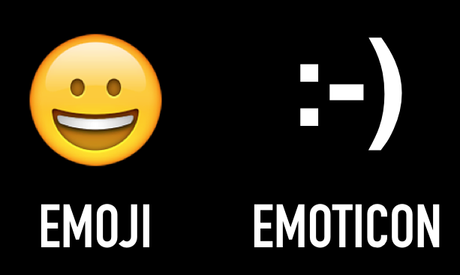
Emoji as a Marketing Strategy?
True, emoji marketing was born as a way for brands and advertisers to connect with and market to millennials and the even more elusive Generation Z.
But… emoji are NOT just for millennials!
Whether it’s because millennials are the trendsetters that the older generations follow (…gasp!… 😮), or because emoji appeal to all ages, four out of five 18 to 65 year-olds use emojis on a regular basis.
- 84% of female and 75% of male respondents believe emojis are a better way to express their emotions than words
- Tweets with emoji receive about 25.4% higher engagement than tweets without
- Facebook posts with emoji have a 57% higher like rate, a 33% higher comment rate, and a 33% higher share rate
So… whatever your business, whatever your target audience, use emoji marketing to humanize your brand.
Use emoji marketing to humanize 👦 👧 👨 👩 your brand.Click To TweetYou are getting excited about this emoji marketing thingy, aren’t you?... 😉😋
Let me give you some practical examples of using emoji in your future marketing campaigns.
Getting Started: 4 Practical Marketing Uses for Emoji
A very simple way to implement emoji into your online communications includes using them in your day-to-day customer interactions.
A smiley face can go a long way! 😀
Emoji marketing via email
We almost expect emoji in social media, but when it comes to email, many of us have not yet made the connection.
Rene Kulka ran a test to see what effect (if any) emoji symbols in email subject lines might have with his subscribers.

He found that email open rate increased by over 20%.
Before you start your own emoji email marketing campaigns, make sure to test your audience preferences as well as the email clients your subscribers use.
Emoji marketing on Instagram
As of March 2015, nearly half of all Instagram text contained emojis.
Here’s something even more exciting: since Instagram allows us to use emoji as hashtags, we are able to see HOW emoji are being used on the platform.
This Instagram emoji study shows that faces account for 6 of the top 10 emoji hashtags. Unsurprisingly, the hearts and hand gestures round out the top 10.
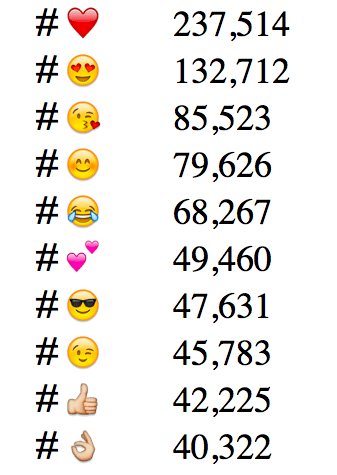
Yes, Instagram loves its hearts. So much so that the heart emoji was the 2014 Global Language Monitor ‘Word of the Year’. The heart emoji averaged 120,000 likes and comments per post!
It’s clear from the top emojis that Instagram is where your target market goes to laugh, be inspired, encourage, and share beauty.
So share the love with your followers and watch the results.
Emoji marketing on Facebook
Facebook is also all about emoji nowadays, although they aren’t quite as prevalent as on Instagram.
However with the release of Facebook Reactions earlier this year, they obviously understand how important emoji are to communication.
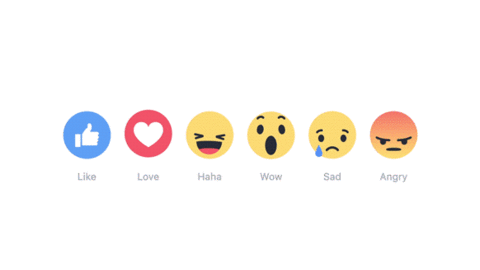
It is not as simple to add emoji to your content on Facebook as it is on Instagram, but it is worth the extra work.
The tool I use to make sure my Facebook posts get the most attention is piliapp.com.
You don’t have to install any software – just click the emoji you want to use, which automatically copies it to your clipboard, then paste it into your Facebook post or comment.
Don’t worry if you see an empty square; Facebook will convert it into the appropriate emoji once you hit publish.
Emoji marketing on Twitter
Larry Kim, founder of Wordstream, is absolutely hands-down the King of Emoji on Twitter.
And it’s not JUST because he’s an emoji junky (👊, Larry!), but because emojis are his secret to better engagement on Twitter.
How much better?

(from Larry Kim’s The Stupid-Simple Secret Ingredient to Better Engagement on Twitter)
As you can see, the emoji version has 25.4% higher engagement (11.06% vs. 8.82%) and a 22.2% lower cost per engagement ($0.18 vs. $0.14).
And, according to Larry, a 25% lift is barely scratching the surface – he’s seen his Twitter engagement as much as triple when emoji were used.
Top that!
And that, my friend, why Larry Kim is Twitter’s undisputed one of a kind 🦄!
How to Add Emoji to Text: Resources
Learn everything you need to know about emoji in Emojipedia.
Easily copy/paste emoji on the web from GetEmoji.com.
Use keyboard shortcuts to make adding emoji a lot more efficient.
How to add emoji on Mac:
- Click on any text field
- Press Command + Control + Space
- Choose your emoji from the list
- Double-click to insert
How to add emoji on Windows:
First, enable the Touch Keyboard option on your desktop; this guide will show you how.
Then:
- Open the Touch Keyboard
- Click on the smiley face emoji icon
- Choose your emoji
Avoid Misusing Emoji
Even though emoji are tons of fun to use and very effective when used strategically, there is an art to using the little guys (and gals!)
Each of our favorite emoji has official meanings, but more importantly, each reader has a perceived meaning for emoji characters.
For instance, did you know that the intended meaning of…
🙏 is a high five.
Now read as two hands in prayer.
👊 is a face punch.
Now widely used as a fist bump.
💁 is an information desk person.
Now used for a variety of interpretations, such as sassiness or sarcasm.
👯 is an iteration of the Playboy Bunny known in Japan as a Bunny Girl.
Now used for dance, but also more broadly for ‘friendship’ and ‘twinsies’.
👯 is also one of the most often impersonated emoji, and there are more than a few photos of people posing as the dancing girls on Instagram.
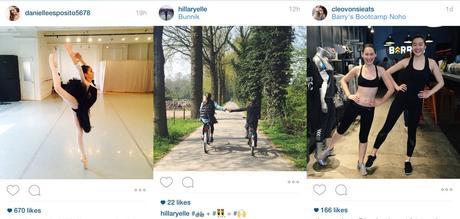
(image source)
Using emojis incorrectly or trying to be too cute can lead to huge misunderstandings!
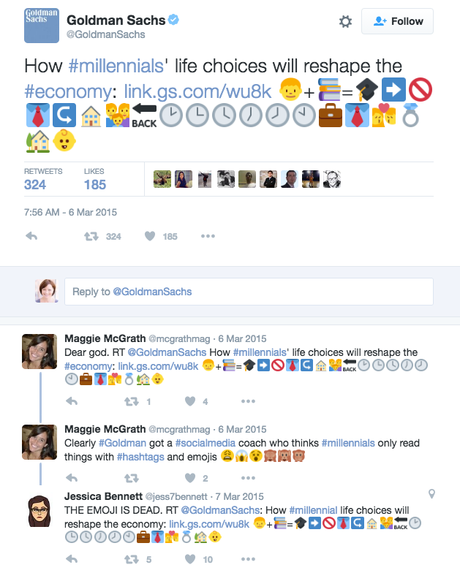
Make sure your messaging is clear when using emoji in your marketing and, when in doubt, avoid their use! It’s just not worth the potential headache…
And this is just plain hilarious:
This is what happens when parents don’t use emojis the right way. pic.twitter.com/KrCbtpG5Kb
— Have A Great Day!!!! (@LoungingWithL) April 17, 2014
Inspiration for Your Emoji Marketing
The only thing missing now is a few examples of emoji marketing done right.
I love finding an amazing social media marketing campaign or example to learn from, and I have found some absolute hum-dingers for you!
Some might not be the best in terms of emoji marketing best practices, but all of the following brought a level of success to their respective brands.
Adidas
Adidas rocked Instagram this Valentine’s Day posting the below photo with the caption: “The love you take is equal to the love you make.”
The love you take is equal to the love you make.
A photo posted by adidas (@adidas) on Feb 13, 2016 at 11:30pm PST
The photo received plenty of criticism from commenters for its portrayal of two women in an embrace, but it was handled beautifully by the Adidas team with some help from our emoji friends.
Sending ‘kisses’ to their homophobic haters was a fun, but also a sensitive touch and a way to end a potentially heated discussion before it even began.
Budweiser
Budweiser is not only the ‘King of Beers’, but they are pretty darn good at emoji marketing too.
This is how Budweiser used emoji to celebrate the 4th of July holiday in America:
??????????????????????????????????????
????????????????????????
??????????????????????????????????????
????????????????????????
????????????????????????????????????????????????
????????????????????????
????????????????????????????????????????????????#4thofJuly— Bud Light (@budlight) July 4, 2014
Deadpool
The marketing for superhero movie Deadpool was something that deserves more than just a mention.
They managed to combine the relevance of emojis with one of the oldest marketing mediums in the book – billboards!
The result was all kinds of fantastic, if not a little crude 😉:
This idiotic/brilliant billboard is why I’m all in on the DEADPOOL movie. I’m an easy lay. pic.twitter.com/jSRorPvaCp
— Patton Oswalt (@pattonoswalt) January 13, 2016
General Electric
One of my personal favorites, GE, used emoji as a teaching tool. They created the website emojiscience.com, which hosted their ‘Emoji Table of Experiments’.
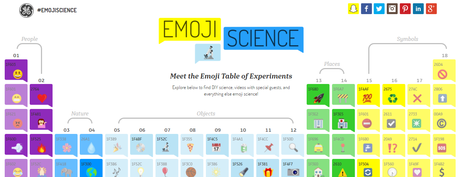
When users click on an emoji, videos with special guests like Bill Nye the Science Guy pop up educating the viewer on a related topic.
Take a look, it’s pretty amazing!
WWF
World Wildlife Fund for Nature is one of my go-to sources for marketing inspiration.
Their Endangered Emoji campaign was flat out spectacular!
Allowing people to use the emoji and then donate to save the endangered species brought much needed awareness and funds.
We’re using #EndangeredEmoji to save real animals from extinction. Please retweet to sign up and help. pic.twitter.com/wmC4mV6r7S— WWF UK (@wwf_uk) March 1, 2016
Domino’s Pizza
Domino’s took emoji marketing to another level, creating a way for users to order pizza in five seconds by using the pizza emoji.
🍕🍕🍕🍕🍕🍕🍕🍕🍕
🍕🍕🍕🍕🍕🍕🍕🍕
🍕🍕🍕🍕🍕🍕🍕
🍕🍕🍕🍕🍕🍕
🍕🍕🍕🍕🍕
🍕🍕🍕🍕
🍕🍕🍕
🍕🍕
🍕— Domino’s Pizza (@dominos) May 12, 2015
Chevrolet
Chevrolet went a bit emoji-crazy when they announced the 2016 Cruze model.
A teaser press release made up entirely of emojis might be too much, but it got noticed and created buzz, so who am I to judge?
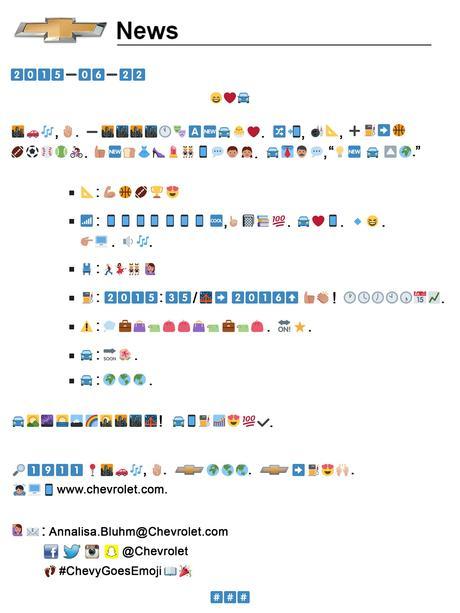
Of course, Chevrolet did follow up the press release with a decoded explanation and a series of YouTube videos 👍.
PETA
PETA launched an Emoji Mobile Marketing Campaign called ‘Beyond Words’ to increase engagement and bring awareness to animal cruelty.
PETA used emoji to convey graphic images of ways that animals suffer cruelty and asked mobile users to text the heart emoji or the keyword HEART to their account.
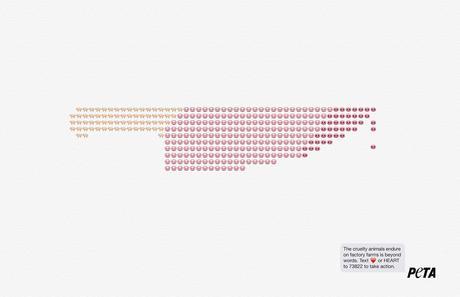
Coca-Cola
Coke’s #ShareaCoke campaign featured a branded emoji that was automatically generated by the hashtag.
In the campaign’s first day alone, the emoji was used over 170,500 times.
Ready for some fun? Tweet #ShareaCoke to help set a new @RecordSetter record for the world’s largest cheers. *clink!* pic.twitter.com/9UmY5WrVKE— Twitter (@twitter) September 17, 2015
Taco Bell
Taco Bell started a virtual petition to have a taco emoji included in the latest round of emoji characters added to Apple and Android operating systems.
33,000 signatures later and the taco was accepted in July 2015.
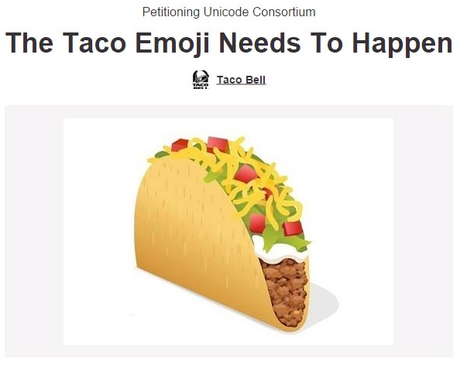
Star Wars
As if the film needed any more marketing, Disney and Lucasfilm partnered with Twitter to develop hashtag-generating emoji to promote The Force Awakens.
Three emojis were designed for #C3PO, #Stormtrooper, and #BB8.
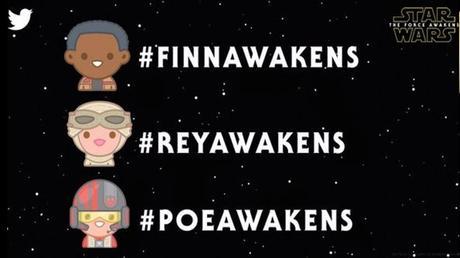
Then, as the film release neared, Disney released emoji for Finn, Rey, and Poe just to make sure that Star Wars would own the Twitter-verse.
Behold: The New Emoji list
The world of emoji is constantly growing.
The most recent batch, Unicode 9, came out in June 2016.
Among the approved emoji?
More faces and smileys – naturally; a key aspect of any emoji update.
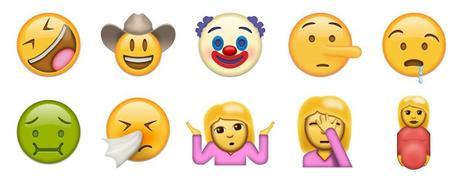
(source: Emojipedia)
7 new hand gestures:

A few new foods, which vary from fruits and vegetables to full dishes:

…including my personal favorite – finally!
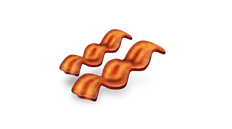
You can learn more about this release in a post at Emojipedia or see the full list here.
According to Emojipedia, support for Unicode 9 emojis will be coming to various devices throughout 2016, with some platforms already including these characters in developer preview builds.
Next Emoji update, Unicode 10, is due for release in mid-2017.
Emoji Marketing Takeaway
There you have it.
Emoji are everywhere, and with a little bit of creativity, I’m confident you will find a way to integrate them into your marketing.
Join the cool kids and get emoji working for you!
Caleb Cousens
Caleb Cousens is the founder of SocialMediaWizard.com, where he teaches readers how to optimize their social and online marketing activities, and where you can download his free Ultimate Blogging Resource.

